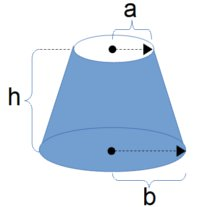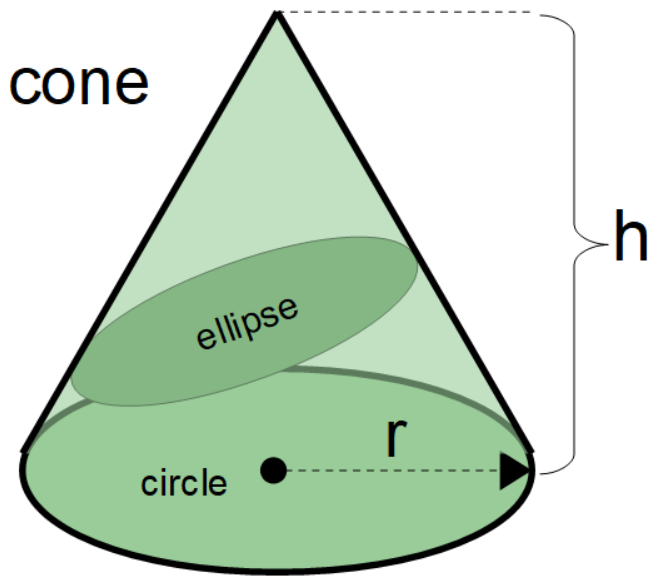The Weight of a Cone Frustum calculator computes the mass (weight) of a right circular cone frustum defined by a top radius (a) and base radius (b), height (h) in between, using the mean density (mD) and volume to calculate the mass of the object. The frustum of a cone is also known as a truncated cone.
INSTRUCTIONS: Choose units and enter the following:
- (a) Top Radius (see diagram)
- (b) Bottom Radius (see diagram)
- (h) Height of Cone Section
- (mD) Mean Density of Material
Weight of a Cone (M): The calculator computes the mass/weight of the cone in grams or kilogram. However, this can be automatically converted to numerous other mass/weight units (e.g. pound, tons) via the pull-down menu. Note: For a complete cone, simple let the top radius (a) remain as zero.
For an instructional video (YouTube) click HERE.

The Math / Science
The formula for the mass or weight of the frustum of a cone is:
`M = [1/3 * π * h(a2+ a*b+ b2)]*ρ`
where:
- M = Mass or weight of frustum of cone
- a = upper radius
- b = radius of base
- h = height of frustum
- ρ = mean density of material in cone
This calculator first computes the Volume of the Frustum of a Cone (CLICK HERE), and then uses that volume with the mean density as follows:
The mean density (mD, μD or ρ) of many common substances, elements, liquids and materials can be found by clicking HERE (e.g. the μD(water) is 1000.0 kg/m³).
Mean Density Table
| Common Mean Densities in Kilograms per Meter Cubed (kg/m3) | ||
|
Fluids
Fuels
Market-Ready Grains |
Metals
|
Earthen
Synthetic
Organic
|
| Mean Density Lookup Function | ||
Mean density is scientifically volume divided by mass. There are various unit for density adopted by cultures and industries. Common units for density included the following:
- kilograms per cubic meter (kg/m3)
- grams per cubic centimeter (g/cm3)
- grams per liter (g/L)
- pounds per cubic feet (lb/ft3)
- ounces per cubic inch (oz/in3)
- pounds per barrel (lb/bbl)
- pounds per bushel (lb/bu)
If you want to identify a material by its density, use the Density Within Range tool.

Weight is technically the downward force that a mass exerts based on the force of gravity and the mass of the object. On the surface of the Earth, mass and weight are often interchanged. In some places, objects are sold by the gram (mass), and in other locations, the same objects are sold by the ounce (weight).
The Weight Calculators use the dimensions of an object and its shape to compute the objects volume. They then apply a density associated with a material to estimate the objects weight.

Weight Calculators
- Weight from Area, Height and Density
- Cube Weight
- Box Weight
- Cone Weight
- Cone Frustum Weight
- Cylinder Weight
- Slanted Cylinder Weight
- Semicircle Weight
- Triangular Weight
- Quadrilateral Weight
- Pentagon Weight
- Hexagon Weight
- Heptagon Weight
- Octagon Weight
- Nonagon Weight
- Decagon Weight
- Hendecagon Weight
- Dodecagon Weight
- Paraboloid Weight
- Polygon Pyramid Frustum Weight
- Sphere Mass
- Sphere Cap Weight
- Sphere Segment Weight
- Sphere Shell Mass
- Oblate Spheroid Mass
- Ellipsoid Weight
- Torus Weight
- Bottle Weight
- Bottle Content Weight
- Chamfer Weight
- Ring Weight
- Cone Surface Area based on cone height and cone base radius
- Cone Volume based on cone height and cone base radius
- Cone Mass or Weight as a function of the volume and mean density
- Cone Frustum Surface Area based on the two heights and two radii
- Cone Frustum Volume based on the two heights and two radii
- Cone Frustum Weight or Mass based on the cone frustum volume and mean density
- Cone Shell Volume a.k.a. hollow cone volume
- Cone Shell Mass or Weight a.k.a. hollow cone mass
- Moment of inertia of a cone shaped object based on mass and rotation axis
- Moment of inertia of a cone shaped object based on mass and distance to apex (rotation around apex)
- Compute the total surface are of the frustum of a cone: This includes the top and bottom surfaces.
- Compute the lateral surface area (using L) of the frustum of a cone.
- Cone Frustum Volume from Angle
- Cone Frustum Height from Volume and Outer Side Angle: Computes height based on volume, small radius and outer side angle.
- Cone Frustum Height from Volume and Inner Side Angle: Computes height based on volume, small radius and inner side angle.
